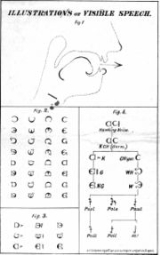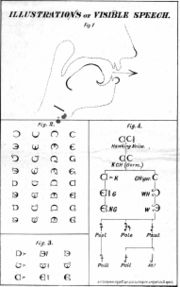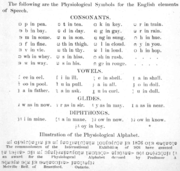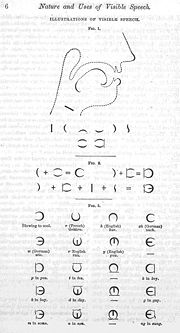
Visible Speech
Encyclopedia



Writing system
A writing system is a symbolic system used to represent elements or statements expressible in language.-General properties:Writing systems are distinguished from other possible symbolic communication systems in that the reader must usually understand something of the associated spoken language to...
used by Alexander Melville Bell
Alexander Melville Bell
Alexander Melville Bell was a teacher and researcher of physiological phonetics and was the author of numerous works on orthoepy and elocution....
, who was known internationally as a teacher of speech and proper elocution
Elocution
Elocution is the study of formal speaking in pronunciation, grammar, style, and tone.-History:In Western classical rhetoric, elocution was one of the five core disciplines of pronunciation, which was the art of delivering speeches. Orators were trained not only on proper diction, but on the proper...
and an author of books on the subject. The system is composed of symbols that show the position and movement of the throat
Throat
In vertebrate anatomy, the throat is the anterior part of the neck, in front of the vertebral column. It consists of the pharynx and larynx...
, tongue
Tongue
The tongue is a muscular hydrostat on the floors of the mouths of most vertebrates which manipulates food for mastication. It is the primary organ of taste , as much of the upper surface of the tongue is covered in papillae and taste buds. It is sensitive and kept moist by saliva, and is richly...
, and lip
Lip
Lips are a visible body part at the mouth of humans and many animals. Lips are soft, movable, and serve as the opening for food intake and in the articulation of sound and speech...
s as they produce the sounds of language, and it is a type of phonetic notation
Phonetic transcription
Phonetic transcription is the visual representation of speech sounds . The most common type of phonetic transcription uses a phonetic alphabet, e.g., the International Phonetic Alphabet....
. The system was used to aid the deaf in learning to speak.
In 1864 Melville promoted his first works on Visible Speech, in order to help the deaf both learn and improve upon their aural speech (since the profoundly deaf could themselves not hear their own aural pronunciations). To help promote the language, Bell created two written short forms using his system of 29 modifiers and tones, 52 consonant
Consonant
In articulatory phonetics, a consonant is a speech sound that is articulated with complete or partial closure of the vocal tract. Examples are , pronounced with the lips; , pronounced with the front of the tongue; , pronounced with the back of the tongue; , pronounced in the throat; and ,...
s, 36 vowel
Vowel
In phonetics, a vowel is a sound in spoken language, such as English ah! or oh! , pronounced with an open vocal tract so that there is no build-up of air pressure at any point above the glottis. This contrasts with consonants, such as English sh! , where there is a constriction or closure at some...
s and a dozen diphthong
Diphthong
A diphthong , also known as a gliding vowel, refers to two adjacent vowel sounds occurring within the same syllable. Technically, a diphthong is a vowel with two different targets: That is, the tongue moves during the pronunciation of the vowel...
s: they were named World English
International English
International English is the concept of the English language as a global means of communication in numerous dialects, and also the movement towards an international standard for the language...
, which was similar to the International Phonetic Alphabet
International Phonetic Alphabet
The International Phonetic Alphabet "The acronym 'IPA' strictly refers [...] to the 'International Phonetic Association'. But it is now such a common practice to use the acronym also to refer to the alphabet itself that resistance seems pedantic...
, and also Line Writing, used as a shorthand form for stenographers.
Melville's works on Visible Speech became highly notable, and were described by Édouard Seguin
Edouard Seguin
Édouard Séguin was a physician and educationist who was born in Clamecy, Nièvre. He is remembered for his work with children having cognitive impairments in France and the United States....
as being "...a greater invention than the telephone
Invention of the telephone
The invention of the telephone is the culmination of work done by many individuals, the history of which involves a collection of claims and counterclaims. The development of the modern telephone involved an array of lawsuits founded upon the patent claims of several individuals...
of his son, Alexander Graham Bell
Alexander Graham Bell
Alexander Graham Bell was an eminent scientist, inventor, engineer and innovator who is credited with inventing the first practical telephone....
". Melville saw numerous applications for his invention, including its worldwide use as a universal language
Universal language
Universal language may refer to a hypothetical or historical language spoken and understood by all or most of the world's population. In some circles, it is a language said to be understood by all living things, beings, and objects alike. It may be the ideal of an international auxiliary language...
. However, although heavily promoted at the Second International Congress on Education of the Deaf in Milan, Italy in 1880, after a period of a dozen years or so in which it was applied to the education of the deaf, Visible Speech was found to be more cumbersome, and thus a hindrance, to the teaching of speech to the deaf, compared to other methods, and eventually faded from use.
Bell's son Alexander Graham Bell
Alexander Graham Bell
Alexander Graham Bell was an eminent scientist, inventor, engineer and innovator who is credited with inventing the first practical telephone....
learned the symbols, assisted his father in giving public demonstrations of the system and mastered it to the point that he later improved upon his father's work. Eventually, Alexander Graham Bell became a powerful advocate of visible speech and oralism
Oralism
Oralism is the education of deaf students through spoken language by using lip reading, speech, and mimicking the mouth shapes and breathing patterns of speech instead of using sign language within the classroom...
in the United States. The money he earned from his patent of the telephone
Telephone
The telephone , colloquially referred to as a phone, is a telecommunications device that transmits and receives sounds, usually the human voice. Telephones are a point-to-point communication system whose most basic function is to allow two people separated by large distances to talk to each other...
and the sale of his Volta Laboratory patents helped him to pursue this mission.
The early years
In 1867, Alexander Melville Bell published the book "Visible Speech: The Science of Universal Alphabetics". This book contains information about the system of symbols he created that, when used to write words, indicated pronunciation so accurately, that it could even reflect regional accents. A person reading a piece of text handwritten in Melville Bell's system of characters could accurately reproduce a sentence the way it would be spoken by someone with a foreign or regional accent. In his demonstrations, Melville Bell employed his son, Alexander Graham Bell to read from the visible speech transcript of the volunteer's spoken words and would astound the audience by saying it back exactly as the volunteer had spoken it.A few samples of the writing system invented by Melville Bell may be seen in the right hand column of this page. These images depict Melville Bell's intention of creating a script in which the characters actually look like the position of the mouth when speaking them out loud. The system is useful not only because its visual representation mimicks the physical act of speaking, but because it does so, these symbols may be used to write words in any language, hence the name "Universal Alphabetics"
Melville Bell's system was effective at helping deaf people improve their pronunciation, but his son, Graham Bell decided to improve upon his father's invention by creating a system of writing that was even more accurate and employed the most advanced technology of the time.
A fresh take on pronunciation for the deaf
Alexander Graham Bell later devised another system of visual cues that also came to be known as visible speech, yet this system did not use symbols written on paper to teach deaf people how to pronounce words. Instead, Graham Bell's system, developed at his Volta Laboratory in Washington, D.C., involved the use of a spectrographSpectrograph
A spectrograph is an instrument that separates an incoming wave into a frequency spectrum. There are several kinds of machines referred to as spectrographs, depending on the precise nature of the waves...
, a device that makes "visible records of the frequency, intensity, and time analysis of short samples of speech". The spectrograph device translated aural acoustic sounds into readable patterns via a photographic process. This system was based on the idea that the eye should be able to read patterns of vocalizations in much the same way that the ear translates these vocalizations into meaning.
Method
The idea of the use of a spectrographSpectrograph
A spectrograph is an instrument that separates an incoming wave into a frequency spectrum. There are several kinds of machines referred to as spectrographs, depending on the precise nature of the waves...
to translate speech into a visual representation was created in the hopes of enabling the deaf to use a telephone. If the sounds could be translated into something readable, then a deaf person at the receiving end could then read out the pattern of speech to determine its meaning without having to hear what was said. The spectrograph readings could also be used to teach pronunciation by having a person speak into the spectrograph and watch a small television-like screen to monitor the precison of their utterances.
See also
- International EnglishInternational EnglishInternational English is the concept of the English language as a global means of communication in numerous dialects, and also the movement towards an international standard for the language...
- Second International Congress on Education of the Deaf
- Universal languageUniversal languageUniversal language may refer to a hypothetical or historical language spoken and understood by all or most of the world's population. In some circles, it is a language said to be understood by all living things, beings, and objects alike. It may be the ideal of an international auxiliary language...
- Volta Laboratory and Bureau
- HangulHangulHangul,Pronounced or ; Korean: 한글 Hangeul/Han'gŭl or 조선글 Chosŏn'gŭl/Joseongeul the Korean alphabet, is the native alphabet of the Korean language. It is a separate script from Hanja, the logographic Chinese characters which are also sometimes used to write Korean...
External links
- Review of Alex Melville Bell's Visible Speech
- Visible Speech with IPA equivalents (Omniglot.com)
- Visible Speech as a Means of Communicating Articulation to Deaf Mutes (American Memory: Alexander Graham Bell Family Papers)
- Description and Overview of Visible Speech, with fonts
- Free font and TeX package for Visible Speech
- Visible Speech, by Alex M. Bell through Google books
- Primer of Phonetics, by Henry Sweet through Google books. A manual on Sweet's revision of Visible Speech, Organic Speech

